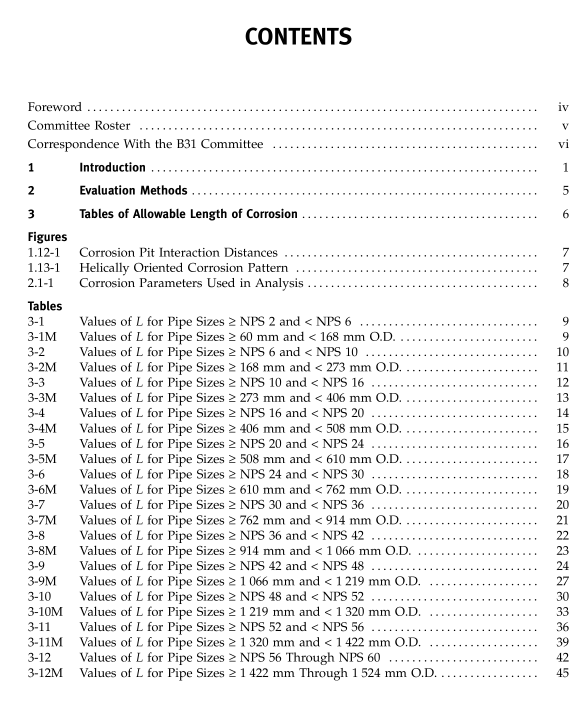ASME B31G pdf download

ASME B31G pdf download Manual for Determining the Remaining Strength of Corroded Pipelines Supplement to ASME B31 Code for Pressure Piping
1.6 Analysis Level
The user may choose to conduct a Level 0, Level 1, Level 2, or Level 3 analysis, depending on the quantity and quality of data available with which to perform an evaluation, and on the desired degree of refinement of the analysis.
(a) A Level 0 evaluation is one that relies on the tables of allowable defect length and depth found in section 3. These tables arecarried overwithoutchange fromearlier editions of ASME B31G and have been supplemented by the addition of tables in metric units.
It is intended that a Level 0 evaluation be conducted in the field with- out the need for performing detailed calculations.
(b) A Level 1 evaluation is a simple calculation that relies on single measurements of the maximum depth and axial extent ofmetal loss. It is intended thata Level 1 evaluation be conducted in the field by an engineer, corrosion technician, coating inspector, or other individ- ual having appropriate training. A Level 1 evaluation is also suitable for use in prioritizing metal-loss anomalies identified by inline inspection.
(c) A Level 2 evaluation is one that incorporates a greater level of detail than a Level 1 evaluation in order to produce a more accurate estimate of the failure pressure. It typically relies on detailed measurements of the corroded surface profile, accounting for the actual distri- bution of metal loss, and involves repetitive computa- tions that may be facilitated by the use of computer software or spreadsheets. It is intended that a Level 2 evaluation be conducted by an engineer or technician having appropriate training.
A Level 2 evaluation may be suitable for use in prioritizing metal-loss anomalies identified by high-resolution inline inspection. (d) A Level 3 evaluation is a detailed analysis of a specific flaw in accordance with a user-defined method- ology, with full justification for loadings, boundary con- ditions, material properties, and failure criteria. It is intended that a Level 3 evaluation be conducted by a technical specialist having appropriate expertise in the subject of fitness-for-service assessment.
1.7 Material Properties and Other Data (a) Specified minimum material properties shall be used when conducting Level 0, Level 1, or Level 2 evaluations for the purpose of determining the need for a repair. Actual material properties from mill test reports (MTRs) or laboratory testing, if known with sufficient confidence to warrant their usage, may be used with Level 3 evaluations. Statistical representations of mate- rial properties may be used with Levels 1, 2, or 3 for purpose ofestablishing a probability offailure; however, the details of such analyses are outside the scope of this document. (b) Flow stress is a conceptrelevanttofracture mechan- ics and is used in the Level 1, Level 2, and Level 3 evaluations. It is not a property specified in a material grade or finished product standard. Research indicates that it may be defined variously as given below.
(1) S flow forplaincarbon steel operatingattempera- tures below 250°F (120°C) may be defined by S flow p 1.1
SMYS. S flow shall not exceed SMTS.
(2) S flow for plain carbon and low-alloy steel having SMYS not in excess of 70 ksi (483 MPa) and operating at temperatures below 250°F (120°C) may be defined by S flow p SMYS + 10 ksi (69 MPa). S flow shall not exceed SMTS.
(3) S flow for plain carbon and low-alloy steel having SMYS not in excess of 80 ksi (551 MPa) may be defined by S flow p (S YT + S UT )/2, where S YT and S UT are specified at the operating temperature in accordance with the ASME Boiler and Pressure Vessel Code, Section II, Part D; applicable pipe product specification; or room tem- perature strength multiplied by the temperature derat- ing factor specified by the applicable construction code. Linear interpolation of strength values is allowed between listed temperatures.
(c) This documentdoes notprescribewhichdefinition for flow stress should be used where more than one definition applies. Where more than one definition applies, the various definitions produce acceptable though not necessarily identical results when used with any given evaluation method. It is noted that S flow was defined as 1.1
SMYS inprevious editions ofB31G. This definition remains an inherent element of the Level 0 assessment and is recommended with the Level 1 assess- ment performed in accordance with para. 2.2(a).
(d) Only the specified nominal wall thickness shall be used for the uncorroded wall thickness when con- ducting a Level 0 evaluation. If known with confidence, the actual uncorroded wall thickness may be used with a Level 1, Level 2, or Level 3 evaluation, with a suitable adjustment of the hoop stress due to internal pressure.
(e) Pipe body material may be considered to have adequate ductile fracture initiation properties for pur- poses of this Standard if the material operates at a tem- perature no colder than 100°F (55°C) below the temperature at which 85% shear appearance is observed in a Charpy V-notched impact test.









